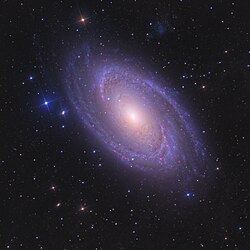Messier 81
 |
|
| M81 by Ken Crawford | |
| Observation data Epoch J2000 |
|
|---|---|
| Constellation | Ursa Major |
| Right ascension | 09h 55m 33.2s |
| Declination | +69° 3′ 55″ |
| Apparent dimension (V) | 26.9 × 14.1 moa |
| Apparent magnitude (V) | 6.94 |
| Characteristics | |
| Type | SA(s)ab,LINER |
| Astrometry | |
| Heliocentric radial velocity | −34 ± 4km/s |
| Redshift | −0.000113 ± 0.000013 |
| Galactocentric velocity | 73 ± 6km/s |
| Distance | 11.8 ± 0.4 Mly (3.62 ± 0.12 Mpc) |
| Other designations | |
Messier 81 (also known as NGC 3031 or Bode's Galaxy) is a spiral galaxy about 12 million light-years away in the constellation Ursa Major. Due to its proximity to Earth, large size and active galactic nucleus (which harbors a 70 million M☉supermassive black hole), Messier 81 has been studied extensively by professional astronomers. The galaxy's large size and relatively high brightness also make it a popular target for amateur astronomers.
Messier 81 was first discovered by Johann Elert Bode on December 31, 1774. Consequently, the galaxy is sometimes referred to as "Bode's Galaxy". In 1779, Pierre Méchain and Charles Messier reidentified Bode's object, which was subsequently listed in the Messier Catalogue.
Most of the emission at infrared wavelengths originates from interstellar dust. This interstellar dust is found primarily within the galaxy's spiral arms, and it has been shown to be associated with star formation regions. The general explanation is that the hot, short-lived blue stars that are found within star formation regions are very effective at heating the dust and thus enhancing the infrared dust emission from these regions.
Only one supernova has been detected in Messier 81. The supernova, named SN 1993J, was discovered on 28 March 1993 by F. García in Spain. At the time, it was the second brightest supernova observed in the 20th century. The spectral characteristics of the supernova changed over time. Initially, it looked more like a type II supernova (a supernova formed by the explosion of a giant star) with strong hydrogen spectral line emission, but later the hydrogen lines faded and strong helium spectral lines appeared, making the supernova look more like a type Ib. Moreover, the variations in SN 1993J's luminosity over time were not like the variations observed in other type II supernova but did resemble the variations observed in type Ib supernovae. Hence, the supernova has been classified as a type IIb, a transitory class between type II and type Ib. The scientific results from this supernova suggested that type Ib and Ic supernovae were actually formed through the explosions of giant stars through processes similar to those taking place in type II supernovae. The supernova was also used to estimate a distance of 8.5 ± 1.3 Mly (2.6 ± 0.4 Mpc) to Messier 81. As a local galaxy, the Central Bureau for Astronomical Telegrams (CBAT) tracks novae in M81 along with M31 and M33.
...
Wikipedia
